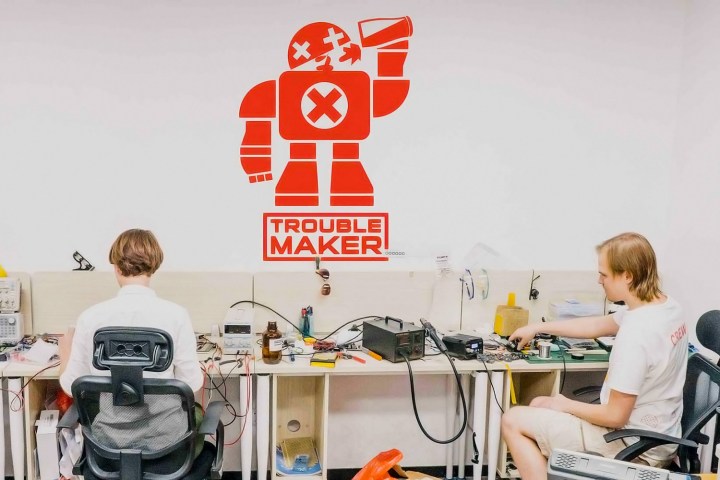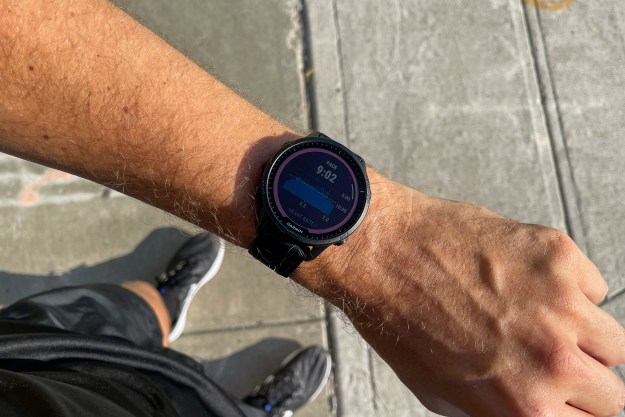
Gone are the days of designing elsewhere and manufacturing in China.
After crossing a small bridge over a koi pond in the lobby, Werner peruses products throughout Artop’s compound: rice makers, cameras, bamboo keyboards, smart pens, hearing aids, RFID devices, sports car consoles, and 3D everything: 3D toy printers, 3D chocolate makers, you name it.
A snippet of conversation catches his attention: An Artop employee telling a dancing robot panda, “Wǒ gǎnmào le” (“I have a cold”). The panda responds, “Nǐ yīnggāi kàn yīshēng” (“you should see a doctor”), then presents nearby options on its interactive screen.
Fine print on the iPhone 7 reads “designed by Apple in California. Assembled in China.” It’s how consumer electronics traditionally get made – and increasingly, it’s not the case. Gone are the days of designing elsewhere and manufacturing in China. Now it’s all happening here.
China’s New Makers
Werner, who runs the Troublemaker makerspace, is exploring partnerships with Artop.In non-mother-tongue English, they discuss maker trends. Given proximity to suppliers, Artop’s innovative director Savio Lai says design and manufacturing happen concurrently in China, not sequentially.
“In the U.K., people have the idea, but they don’t know how to do the manufacturing,” he told Digital Trends. Because Chinese have manufacturing experience, designs more closely resemble finished products. But Chinese manufacturing is changing. “Lots of mass production companies are facing trouble because everybody wants personal products,” Lai says.

Troublemaker and Artop provide similar services, but scale differentiates them. Founded 18 years ago, Artop Group has more than 1,000 employees and provides inventors with capital. Troublemaker launched last year, doesn’t have any payrolled employees, and hasn’t yet funded a project. With a chuckle, Artop general manager Jeffrey Zhu says in Mandarin, “You have one designer. We have 200.”
The two firms can collaborate, however. After developing prototypes at Troublemaker, inventors need resources Artop provides – financing, expertise, product certifications, and distribution connections. These services do come with a price, though. Werner presses them on manufacturing costs and lead times.
“Mass production companies are facing trouble because everybody wants personal products.”
He also raises trust concerns. “Not everybody has a positive experience working in China,” he says. To prevent copycatting – long a problem with Chinese companies — product designers outsource different processes and parts to multiple manufacturers. Werner stresses non-disclosure agreements. He bluntly tells Artop, “People put several years of their life into the product and they don’t have the power to stop you if you do something wrong.”
Werner regularly meets with programmers, engineers, angel investors, venture capitalists, investment bankers, and component suppliers. It’s not always fruitful, however. “Meetings like this take half a day, maybe more, and you don’t know what you get out of it, if anything,” he says.
It is gratifying, though. “I work a lot, but 90 percent of the time I don’t have a feeling I’m working, because I like to do it,” he says. He departs Artop for a lunch that is part recruitment, part career counseling.
Who Are Today’s Troublemakers?
Troublemaker clients “have ideas and passion, but not the money,” Werner says. One client is perfecting the unicycle. “This guy wakes up with a unicycle between his feet and goes to bed with it. Rides one every day. No one else in China will do it the way he will,” Werner says of the inventor, who needs funding and business advice.
Troublemaker is nestled in the heart of Huaqiangbei Road, renowned for electronics and components. The company’s shared floor — which has conference rooms, a café with foosball, and outside patio — is adorned year-round with “Merry Christmas” signs, trees, wreathes, and faux gifts.
Troublemaker provides desks and a workshop, which has hand tools, 3D printers, a CNC machine, laser cutter, vacuum laminator, welding machine, and mini assembly line. A half-dozen “gurus” – electronics engineer, industrial designer, structural designer, software engineer, front-end web developer, automotive engineer – offer services à la carte.

Client agreements range from daily to monthly. There’s no application process and profit is secondary. “I’m not that commercial,” Werner says. “Everything is started at improving the lives of people involved.”
Clients predominantly develop hardware projects such as educational robots, in-ear audio devices, diaper sensors for incontinent patients, and even a bowling ball launcher for children and people with disabilities. They come from Australia, China, Europe, Korea, Russia, the United States, and the United Kingdom. Most are in their 30s, but not all.
Werner says of one client, Kevin Norman, “I love the guy. 70 years old, but still trying to do something good for the world.”
Prior to being interviewed, Norman, a self-described Colorado farm boy, ventures outdoors to smoke. “I’m a bad man,” he says. Norman is designing a video course and educational robot to teach children Python, a programming language.
Silicon Valley reigned supreme in the 80s, but Shenzhen is the world’s electronics hub today.
In the 1980s, Norman programmed video games. He transitioned into educational science and was manufacturing in China by the 2000s. Sporting glasses, saggy jeans, and an orange button-down, Norman tells Digital Trends, “That was kind of a very bizarre experience. I had never been out of the United States except to Canada.”
Upon retirement in 2014, Norman commenced this project. “I like designing things, building things,” he says. Needing a 3D printer, he joined Troublemaker on day one. He also appreciates bouncing ideas off others. “I need a certain amount of interaction,” he says.
Norman says Silicon Valley reigned supreme in the 80s, but Shenzhen is the world’s electronics hub today. Any part he needs, he strolls across the street to buy. “This is where it’s happening,” he says.
Norman says government officials are making Shenzhen the “Silicon Valley of the world.” Additionally, citizens are participating. He cited a local innovators fair, where high turnout shut down the nearest subway station. “You don’t see a hundred thousand people going to a trade show, dragging their children in San Francisco. Maybe at football games you get 100K, but you don’t get it for tech shows.”
Fostering creativity
Troublemaker’s Werner came to China six years ago as an LED consultant and sourcing agent. “I fell in love with the people and food,” he says. Walking in the middle of a side street, Werner is unfazed by oncoming scooterists, exemplifying either his adaptive abilities or inattention to his surroundings.
Ahead, a mid-20s tattooed woman in a tank top emerges from a building. Jiahui “Eve” Tan lives in a 3-bedroom apartment with two roommates, three turtles, two cats, one dog, and a hamster. In her spacious bedroom, the freelance art teacher exhibits recent projects – epoxy houses with LED lights, seashells with miniature figurines.
To engender creativity in children, Troublemaker offers workshops. The first course was on robots. Going forward, Werner wants to cover wastewater treatment, renewable energy, indoor farming, and 3D printer design.
“You need people who have the passion and creativity to just do things. A lot of people just don’t do things,” Werner says.
Tan laments rote learning used in Chinese classrooms. “Students cannot be creative, cannot design sketches,” she says.
“You need people who have the passion and creativity to just do things.”
In a modest dining room with white walls and high ceiling, they discuss her future over rice, cabbage, spicy pork, herbal iced tea, and watermelon. They discuss potentially holding art classes at Troublemaker. Like the morning meeting, however, nothing is finalized.
With four children, Werner never had time to learn Mandarin. A woman speaking the mother tongue calls. He thinks she’s a telemarketer before handing Tan the phone. It’s the police. In China, foreigners must register housing details with authorities. Werner is a month overdue.
It’s 2:30 pm. By 5:00 pm, he must cross a city that is geographically 1.6 times the size of Los Angeles or risk being barred from leaving the country. Werner appears unbothered. After repeated prompting from Tan, he acknowledges the urgency and sets out.
Although registration takes but five minutes, the trek devours three hours. “I should make time for these things,” he says.




